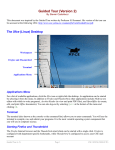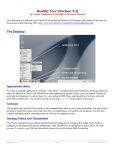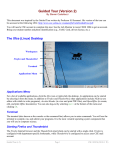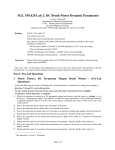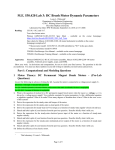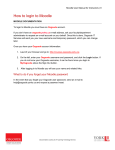Download Guided Tour (Version 3.2)
Transcript
Guided Tour (Version 3.2) By Steven Castellucci This document was inspired by the Guided Tour written by Professor H. Roumani. His version of the tour can be accessed at the following URL: http://www.cse.yorku.ca/~roumani/jbaYork/GuidedTour.pdf. The Desktop Application menu File Manager Terminal Emulator Web Browser Email Client Virtual desktops Applications Menu For a list of available applications, click the “CSE Menu”. An application can be started by selecting it from the menu or entering a command in the terminal emulator. You can also log-out by selecting Log Out at the bottom of the menu. Terminal Emulator The terminal emulator (also known simply as “the terminal”, “the console” or “the command-line”) allows you to enter commands. You can use the terminal to make directories, move and copy files, and run applications. It is the most versatile operating system component that you will use in computer science. Please refer to the section Simple Terminal Commands. Virtual Desktops You can arrange you windows across four virtual desktops. Although you can only work with one at a time, the applications on all desktops remain running. Scrolling the mouse wheel on the desktop will display the virtual desktops in sequence. (You can also click on the thumbnail images along the bottom of the screen.) Even if you do not use the virtual desktops, make sure that you do not accidentally switch to them as you work. Guided Tour (v3.2) Page 1 EECS 1020 (2014-15 F) Mail Forwarding You can have your Department mail automatically forwarded to the email account of your choice (e.g., yorku.ca, gmail.com). To do so, open a web browser and go to mail.cse.yorku.ca. Log-in using your EECS username and password. From the left pane, select Options, then Mail. From the center pane, select Filters, Edit your filter rules, then Forward. Enter your other email address(es) and click Save. To test the forwarding, send an email to your CSE address (e.g., username@cse.yorku.ca) and check your other email address(es). Printing Files You have a print quota of 500 pages. To display the number of pages remaining in your quota, enter the command pquota using the terminal. Typically, you can print an open file by selecting Print from the File menu. After you send the file to be printed, go to any print station in room CSEB 1002, 1004, or 1006. Touch the screen to activate it. Enter your username and password using the attached keyboard. Ensure that the files you want printed are selected, and press the print icon in the bottom-left corner. To exit without printing, press the exit icon. If you experience any printing problems, contact the lab monitor. Configuring eCheck Each chapter of the textbook contains programming exercises called “eChecks” (programs that are checked electronically). However, you must first configure the eCheck program that checks your code. Enter the command java Options at a terminal. Uncheck “Work Offline”. Enter your username, password, and the following URL: https://www.eecs.yorku.ca/~roumani/type/ec/ec.cgi Double-check that you entered the URL correctly. When you are finished, click Apply. Guided Tour (v3.2) Page 2 EECS 1020 (2014-15 F) Creating a Java Program Open a terminal emulator by clicking on its icon at the bottom of the screen. Type jedit & and press Enter on the keyboard. Including the ampersand (&) will allow to you to use the terminal while jEdit is running. Type the following code in the jEdit window and save the file as First.java. Guided Tour (v3.2) Page 3 EECS 1020 (2014-15 F) Back at the terminal, compile your program by entering the command javac First.java. If there are any errors outputted to the screen, return to jEdit and correct them. Make sure you save your changes and compile your code again. Once your code compiles, run your program by entering the command java First at the terminal. Note that the command is java, not javac. Furthermore, note that the .java file extension is omitted. The output should be “My name is ???”. Close the jEdit window. Before we change the program to output your username, let us create a directory in which to organize your work. Enter the command clear to clear the current contents of the terminal window. Guided Tour (v3.2) Page 4 EECS 1020 (2014-15 F) Enter the command ls to list the contents of the current directory. Directories appear in purple, files typically appear in black. In this directory are (at least) two files: the source file and the compiled class file. Make a directory called “1020”. To do this, enter mkdir 1020 at the terminal. Enter the command ls again to see that the directory was created. Now, move both files to the 1020 directory. Because both files have similar names, we can use the asterisk wildcard (*) to represent both file extensions. Enter the command mv First.* 1020. The first argument represents the files to move, and the second argument represents the destination directory. Commands entered at the terminal typically affect the current directory, which appears in the title bar. Enter the command cd 1020 to change the current directory (your home directory) to the 1020 directory. Notice the change in the title bar. Enter ls to see the contents of this directory. The two “First” files should be there. Guided Tour (v3.2) Page 5 EECS 1020 (2014-15 F) Rename the First.java file to be Check01A.java. In Linux, the mv command is used to move files, as well as rename them. Enter the command mv First.java Check01A.java. In this case, the first argument represents the current filename, and the second argument represents the new filename. Now that the file is renamed, the old class file is no longer needed. Delete it using the command rm First.class. Use the rm command with caution, as files are not moved to a Trash or Recycle Bin; they are deleted permanently. Try compiling the Check01A class. You will receive a syntax error, stating that the filename should be changed to the class name. Open jEdit again to edit the source code. This time, use the command jedit Check01A.java & to start jEdit and automatically open the file Check01A.java. Again, the use of the ampersand (&) allows the terminal window to be used while jEdit is running. Guided Tour (v3.2) Page 6 EECS 1020 (2014-15 F) Make two changes to the source code: (1) change the name of the class to Check01A; and (2) replace “???” with your EECS username. Compile your code again. Correct any syntax error that exist, save your changes, and recompile. When there are no compilation errors, check your program using eCheck. The command to run eCheck is java eCheck ###, where “###” is replaced with the code for that eCheck exercise. For this exercise, the code is “01A”. The eCheck output will indicate that there is a discrepancy in your program’s output. In this case, “name” should be replaced with “Account Number”. Guided Tour (v3.2) Page 7 EECS 1020 (2014-15 F) Return to jEdit and make the required changes to your code. Save the changes, recompile your code, and run eCheck again. The eCheck program will indicate when your program has passed all tests. If your program’s output does not match the expected output, identify the discrepancy, change your code to correct the mismatch, and eCheck your program again. Auto-Completion and Command History You do not have to type entire filenames or directory paths. Type the first couple of characters, followed by the Tab key. The operating system will complete the rest of the name or path. If there are multiple matches, the operating system will complete only the common portion. You will have to type additional characters to identify the desired file or directory. To repeat a command at a terminal, you can use the up- and down-arrow keys to cycle through commands you previously entered. Simple Terminal Commands Command: man command Example: man submit Description: Displays the user manual for the passed command. The user manual details the type and number of arguments required by the command, and lists all the available command options. To scroll through the user manual, press the spacebar. To exit the user manual, simply press the Q-key. Guided Tour (v3.2) Page 8 EECS 1020 (2014-15 F) Command: mkdir dirName Example: mkdir eChecks Description: Creates a subdirectory with the passed name in the current directory. The example creates a subdirectory called “eChecks”. Command: cd dirName Example 1: cd Example 2: cd .. Example 3: cd mail Description: Without any argument (Example 1), this command changes the working directory to your home directory (equivalent to the “My Documents” folder in Windows). With the argument “..” (Example 2), this command changes the working directory to the parent directory. If you provide the name of a subdirectory as an argument (Example 3), this command changes the working directory to be that subdirectory (e.g., the subdirectory called “mail”). Command: ls dirName Example 1: ls Example 2: ls mail Example 3: ls *.txt Description: Lists the contents of the directory specified by the argument. Without any arguments (Example 1), this command lists the visible contents of the working directory. If the argument is a directory name (Example 2), this command lists the visible contents of that directory (e.g., the subdirectory called “mail”). Example 3 lists all files in the current directory that have a “.txt” extension. You can use the “*” wildcard to search for files that match a pattern. There are many options for this command, such as “-a” to show hidden files and “-l” to show file and directory details. Enter the command man ls for further details. Command: rm fileOrDir Example 1: rm First.java Example 2: rm –r eChecks Description: Removes the file or directory indicated by the argument. The first example deletes the file “First.java”. The second example (note the “-r” option) removes directory called “eChecks” and all of its contents. Use this command with caution! Command: cp orgnl cpy Example: cp First.java First_backup.java Description: Copies the file orgnl to the location cpy. The example creates a copy of “First.java”, called “First_backup.java”. Command: mv old new Example: mv First.java Second.java Description: Moves the file old to the location new. This command can also be used to rename files. The example renames “First.java” to “Second.java”. Guided Tour (v3.2) Page 9 EECS 1020 (2014-15 F)









